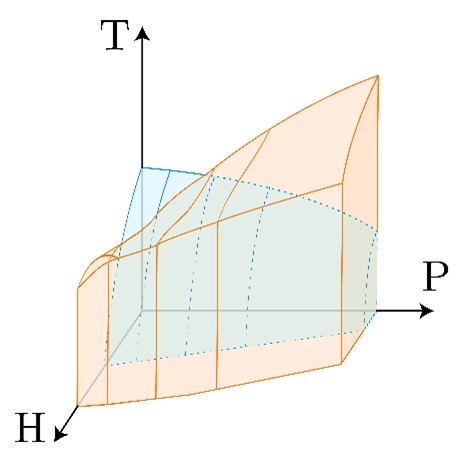The so-called
conventional* superconductivity characterised by the vanishing of electrical resistance at low temperature (T) has been well described since the 50’s. However, some superconductors, deemed
unconventional* exhibit some intriguing, exotic properties such as robustness against magnetic field (H) or the emergence of several distinct superconducting phases under various conditions for T, H or external pressure (P).

Figure 1: Pressure-field-temperature phase diagram of UTe2. The blue and orange regions depict two distinct superconducting phases. The results that helped to build this figure are detailed in Figure 2.
One of the most striking examples of such materials is UTe2 whose singular phase diagram is showed in
Figure 1. Since the discovery of its superconductivity in 2018, the researchers from around the world have been unveiling more and more of its astounding properties. When cooled to temperatures below 2 K, a first, single superconducting phase (SC1) appears. Surprisingly, a second superconducting phase is stabilised and reinforced when a strong magnetic field is applied to the sample. Finally, a third superconducting phase emerges under strong pressure (approximately 0.2 GPa, i.e. 2 000 times the atmospheric pressure). The researchers from
CEA-IRIG/PHELIQS recently sought to study the behaviour of UTe2 under even more extreme conditions, by applying at the same time both strong magnetic fields and pressure. To this end, specific heat measurements have been carried out at the
Laboratoire National des Champs Magnétiques Intenses (LNCMI) in Grenoble, in collaboration with researchers from LNCMI and Tohoku university, in Sendai, Japan. The results unambiguously show that both the field-induced and pressure-induced superconducting phases are in reality only one single phase: SC2 (Figure 2).

Figure 2: critical field of UTe2 as a function of temperature, for different values of pressure. Without pressure nor field, UTe2 undergoes a transition from a normal state N to a superconducting phase SC1 at around 2 K. The second superconducting phase SC2 occurs either under field (15 T) at ambient pressure, or under pressure (0.2 GPa) at zero field, while evolving in a continuous manner. Thus, SC2 really constitutes a single “high-pressure / high-field” superconducting phase.
This rather “simple” result actually raises a very complex question: what kind of pairing mechanism, responsible for this particularly robust superconducting phase, could be reinforced either by applying a strong magnetic field, or pressure?
In the first case, the magnetic field favours spin alignment until achieving a meta-magnetic transition into a ferromagnetic-like, spin-polarised state. On the contrary, pressure seems to promote an antiferromagnetic state, which makes it very tough to conciliate the two scenarios. Exotic superconductors such as UTe2 often reveal puzzling properties when subjected to extreme conditions of field or pressure.
Today, characterising the microscopic properties of the interactions that make superconductivity possible in UTe2 is a major fundamental challenge, and these recent results draw yet another target for future theoretical models and experiments that are currently working towards a better understanding of this unconventional superconductivity.
GLOSSARY
Conventional superconductors*: They have been well described since the elaboration of the BCS theory (Nobel Prize 1972). The mechanism allowing superconductivity to appear has been identified as the vibrations of the atomic lattice (phonons). Among them are found most of the pure elements (e.g. mercury), some alloys such as niobium-titanium (used in most MRIs) but also the recently found pressure-induced hydrides.
Unconventional superconductors*: In unconventional superconductors, the mechanism underlying superconductivity does not emerge from an electron-phonon interaction, but rather from more direct electron-electron interactions (those involving magnetic properties for instance). Unconventional superconductors are often found among several families in which electrons states are strongly entangled. Examples of such strongly-correlated electron compounds are the high-temperature cuprates, iron-based pnictides, or even uranium-based heavy-fermion compounds such as UTe2.